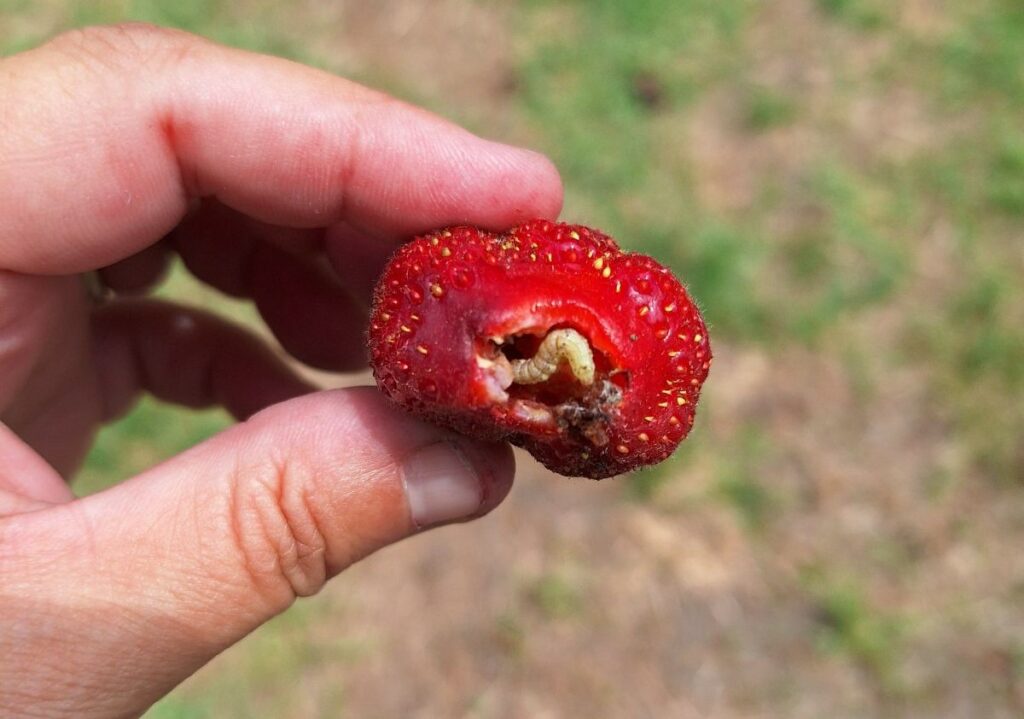Corn Earworms and Lygus Bugs Infesting Strawberries
go.ncsu.edu/readext?1003943
en Español / em Português
El inglés es el idioma de control de esta página. En la medida en que haya algún conflicto entre la traducción al inglés y la traducción, el inglés prevalece.
Al hacer clic en el enlace de traducción se activa un servicio de traducción gratuito para convertir la página al español. Al igual que con cualquier traducción por Internet, la conversión no es sensible al contexto y puede que no traduzca el texto en su significado original. NC State Extension no garantiza la exactitud del texto traducido. Por favor, tenga en cuenta que algunas aplicaciones y/o servicios pueden no funcionar como se espera cuando se traducen.
Português
Inglês é o idioma de controle desta página. Na medida que haja algum conflito entre o texto original em Inglês e a tradução, o Inglês prevalece.
Ao clicar no link de tradução, um serviço gratuito de tradução será ativado para converter a página para o Português. Como em qualquer tradução pela internet, a conversão não é sensivel ao contexto e pode não ocorrer a tradução para o significado orginal. O serviço de Extensão da Carolina do Norte (NC State Extension) não garante a exatidão do texto traduzido. Por favor, observe que algumas funções ou serviços podem não funcionar como esperado após a tradução.
English
English is the controlling language of this page. To the extent there is any conflict between the English text and the translation, English controls.
Clicking on the translation link activates a free translation service to convert the page to Spanish. As with any Internet translation, the conversion is not context-sensitive and may not translate the text to its original meaning. NC State Extension does not guarantee the accuracy of the translated text. Please note that some applications and/or services may not function as expected when translated.
Collapse ▲The corn earworm (Helicoverpa zea, Lepidoptera: Noctuidae), a significant pest known for its broad host range, has been reported infesting various strawberry fields in North Carolina and Virginia this week. This pest, typically found in corn and tomatoes, can cause extensive damage to strawberries, affecting the fruit quality and yield.
Because the earworms feed directly on the fruit, contact insecticides are not likely to control them. Systemic insecticides that move through the plant tissue, such as Coragen (chlorantraniliprole), or insecticide products with translaminar activity that move inside the leaf tissue where they are applied, such as Harvanta (cyclaniliprole),are the best option to remediate these outbreaks. Two insecticide applications scheduled one week apart are enough to mitigate infestation. Some formulations of Bt-based insecticides are approved to control corn earworms in organically-grown strawberries.
The Tarnished plant bug also also known as Lygus bug (Lygus lineolaris, Hemiptera: Lygaeidae, is the eastern US species) has also been reported in various strawberry farms in North Carolina. This pest usually infest strawberries during the last weeks of harvest in early June. However, moderate to severe infestations have been observed 2-3 weeks early this year.
Feeding by nymphs and adults results in distorted, “cat-faced” strawberries due to seed feeding. Lygus bugs start feeding on small growing fruit that limits its normal growth causing deformed (“cat-faced”) unmarketable fruit. These insects can be easily seen with the naked eye resting on the plants during the day.
Because Lygus bugs are highly mobile, systemic products are the best option to remediate early outbreaks, such as Transform (sulfoxaflor) or Assail (acetamiprid). These products are highly toxic to bees; thus, read the label closely to keep your pollinators safe and apply them as late as possible in the day to avoid overlaps with the bees’ activity peak.
Damaging population outbreaks of corn earworms and Lygus bugs in strawberries are most likely to occur during periods of warmer than usual temperatures. Historical temperature data for NC indicate that maximum temperatures in May fluctuate close to 80°F. However, we reached more than 90°F during the 1st week of May, which may have contributed to the establishment of these pests.
Refer to the North Carolina Agricultural Chemicals Manual for materials recommended for use against corn earworms and Lygus bugs in North Carolina and the Southern Region Small Fruit Consortium Strawberry IPM Guide for regional recommendations.







